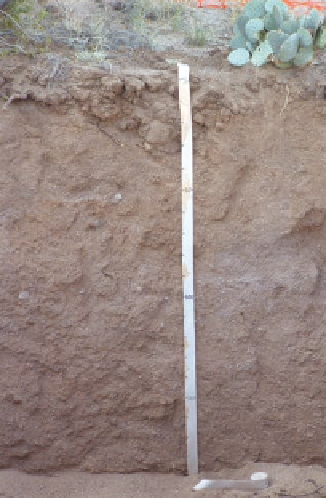Geoscience Reference
In-Depth Information
The combination of high amounts of organic matter and
minerals makes Mollisols among the most fertile and produc-
tive soils on Earth because they contain abundant nutrients that
plants need. In the United States, Mollisols support a wide vari-
ety of agricultural crops, including corn, wheat, and soybeans.
The next loaf of bread you buy, in fact, will most likely contain
wheat grown in Mollisols.
of Earth's ice-free land area, including the Sahara Desert and
significant parts of Australia, South America, the Middle East,
Asia, and the southwestern United States (Figure 11.31a). These
dry environments have very sparse vegetation (Figure 11.31b),
which means that Aridisols have poorly developed A horizons,
if they have them at all (Figure 11.31c).
Aridisols can form through either the process of calcifi-
cation or another process called
salinization
, which entails
the movement of sodium (Na) in the soil. In the other pedo-
genic processes, such as laterization and podzolization,
Aridisols
As the name implies,
Aridisols
are soils that form
in arid environments. These soils are found over about 12%
Global distribution of Aridisols
(a)
(c)
(b)
(d)
Figure 11.31 Aridisols.
(a) Generalized map of Aridisols on Earth. These soils occur on about 12% of Earth's ice-free land area. (
Source:
U.S. Department of Agriculture.) (b) A typical Aridisol landscape in the southwestern United States. (c) An Aridisol in New Mexico. Note
the lack of a well-developed A horizon, which is a reflection of the desert environment. (d) An Aridisol with a calcic horizon (arrow) in New
Mexico. This horizon developed through extensive eluviation of calcium over a long time.
Aridisols
Mineral soils that form in arid environments and
thus are poorly developed.
Salinization
A regional soil-forming process in which soluble
salts are cycled within the soil.





































































































































































